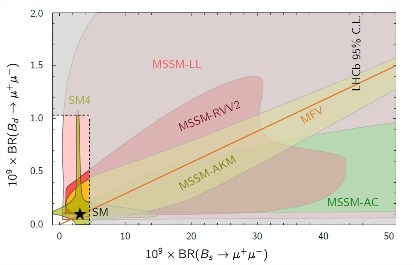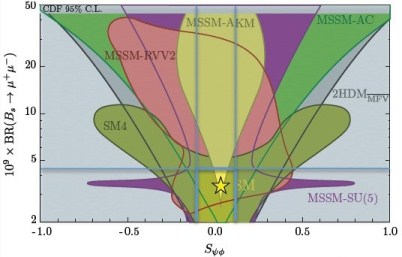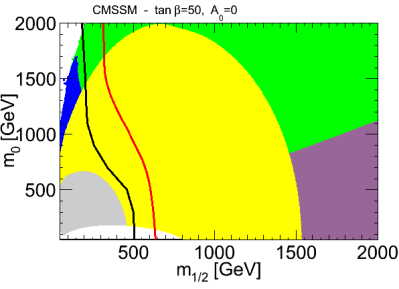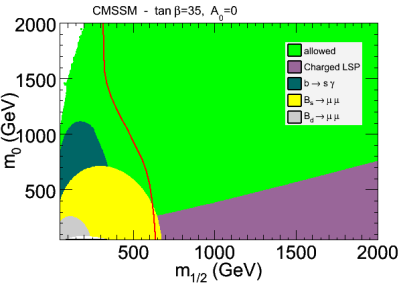Results presented by the LHCb Collaboration at the Rencontres de Moriond EW and QCD conferences allowed theorists to squeeze strongly the parameters of supersymmetric extensions of the Standard Model (SUSY), the most popular new physics model. The simplest version of this model, called the Minimal Supersymmetric Standard Model (MSSM), predicted the frequencies with which Bs and Bd mesons decay into pairs of oppositely charged muons to have values significantly different from the Standard Model (SM) prediction. This is shown in the left image below, which was presented by David Straub (SNS and INFN, Pisa) at the Moriond EW conference. The predictions for both frequencies (branching ratios BR) depend on different parameters of the MSSM and cover nearly all of the left image surface. The LHCb results, see 5 March 2012 news, limit the predictions that are still allowed to a small region around the SM expected value. It is interesting to note that certain combinations of MSSM parameters allow lower BR values than those predicted by the SM. The LHCb measurements of the parameter φs, which sets the scale for the difference between properties of matter and antimatter for the strange beauty Bs mesons, see 5 March 2012 news, also strongly limits the SUSY parameter space that is still allowed, as shown by the vertical lines on the right image below.
SUSY contributions to observables that can be measured in experiments depend, in general, on more than 100 free parameters. Therefore in order to be able to analyse experimental data physicists are using a simplified model, the Constrained MSSM (CMSSM), with 5 parameters m0, m1/2, A0, tan β and μ/|μ|. Nazila Mahmoudi (Clermont-Ferrand and CERN) presented the left image below at the Moriond QCD conference. The parameter space below and to the left of the red line is excluded by the results of searches for direct production of SUSY particles at the CMS experiment, while the large yellow region shows the parameter space excluded by the analysis of Bs →μμ decays at LHCb. The image is made for a relatively high value of the parameter tan β=50. The LHCb exclusion region is smaller at lower values of tan β as can be seen in the right image below, made with tan β=35. The green regions on both images are still not excluded by LHCb’s measurements.
click the image for higher resolution
The images above illustrate that direct and indirect SUSY searches at LHC are complementary and show that the allowed parameter space is characterized by low tan β and high m0 and m1/2 within the CMSSM. LHCb’s results have ruled out large deviations in several observables, but now LHCb physicists can start to probe the most interesting parameter region of new physics.




